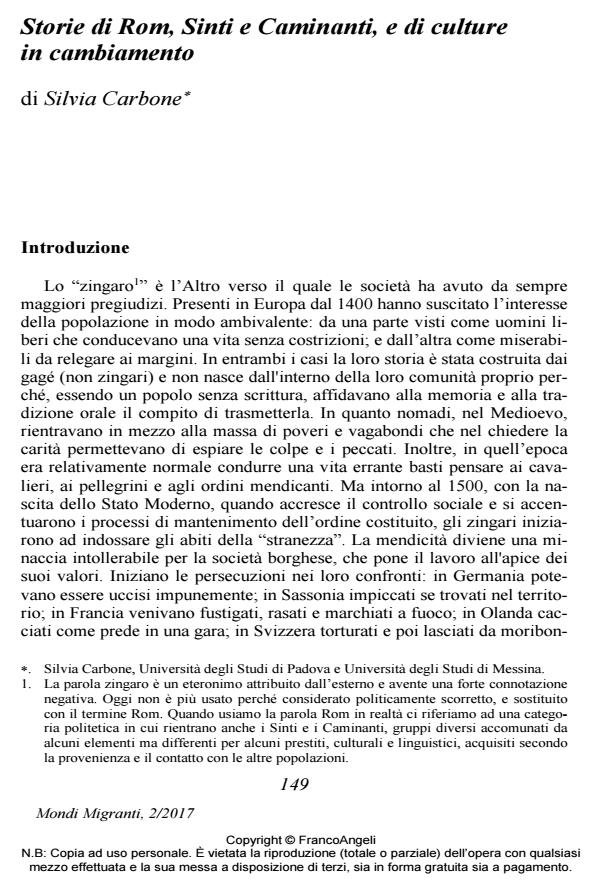Roma, Sinti and Caminanti stories: between cultural change and integration
Journal title MONDI MIGRANTI
Author/s Silvia Carbone
Publishing Year 2017 Issue 2017/2 Language Italian
Pages 12 P. 149-160 File size 183 KB
DOI 10.3280/MM2017-002008
DOI is like a bar code for intellectual property: to have more infomation
click here
Below, you can see the article first page
If you want to buy this article in PDF format, you can do it, following the instructions to buy download credits

FrancoAngeli is member of Publishers International Linking Association, Inc (PILA), a not-for-profit association which run the CrossRef service enabling links to and from online scholarly content.
The Roma, Sinti e Caminati, more than any other group who is at the margins of society can make to reflect on the question of integration. But what role does the Roma culture in this process? And what culture are we talking about? In an attempt to seize their "cultural approach" it tried to deconstruct the rigid image of identity that was sewn on them. They were made 30 indepth interviews with a group of Roma Messina involved in a project of integration of social housing promoted in 2011 by the Municipality and the Ministry of Labour and Social Policy. I integrated the collection of interviews with participant observation, so collecting data on the physical environment, the homes, the neighborhood and the space relationships of the members of the group Roma. The aim of the research was to understand how those involved perceive their own culture and values which give more importance. The result that has emerged is the existence of new interstices in which they are located that movement, that cultural change can generate integration.
Keywords: Keywords: Rom; Cultures; Immigration; Integration; Qualitative.
- Bastide R. (1996). Continuité e disconinuité des societies et de cultures afroaméricanes. Bastidiana, 13-14.
- Bastide R. (1975). Acculturation. Encyclopaedia Universalis. Paris.
- Bateson G. (1976). Verso una ecologia della mente. Milano: Adelphi.
- Benedict R. (1934). Patterns of Culture. New York: Houghton Mifflin.
- Bennet M.(2002). Principi di comunicazione interculturale. Milano: FrancoAngeli.
- Berger P.L., Luckmann T. (1967). The social construction of reality New York: Doubleday & Company.
- Boas F. (1940). Race, language and culture. New York: Columbia University.
- Boudelaire C. (1997). I fiori del male. Milano: Fabbri.
- Bousier G., Coverso M., Iacomini F. (1996). Zigeuner: lo sterminio dimenticato. Roma: Sinnos.
- Bragata S., Menetto L. (2007). E per patria una lingua segreta. Rom e Sinti in provincia di Venezia. Portogruaro: Nuova Dimensione.
- Bravi L. (2009). Tra inclusione ed esclusione. Una storia sociale dell’educazione dei Rom e dei Sinti in Italia. Milano: Unicopli.
- Brunello P. (1996). L’urbanistica del disprezzo. Campi Rom e società italiana. Roma: Manifestolibri.
- Castel R. (2004). L’insicurezza sociale. Torino: Einaudi.
- Cuche D. (2003). La nozione di cultura nelle scienze sociali. Bologna: il Mulino.
- De Vaux De Foletier F. (1977). Mille anni di storia degli zingari. Milano: Jaca.
- Foucault M. (1976). Sorvegliare e punire. Nascita della prigione. Torino: Einaudi.
- Kroeber A.L. (1948). Antropology : Race, language, culture, psychology, pre-history. New York: Harcourt, Brace.
- Kroeber A.L. (1952). The concept of culture in Science. The nature of culture (pp.118-135). Chicago IL: University of Chicago Press.
- Malinowski B. (1944). A Scientific Theory of Culture and Others Essays. Chapel Hill, N. Carolina, The University of North Carolina Press.
- Mead M. (1928). Coming of Age in Samoa: A Psychological Study of Primitive Youth for Western Civilization. New York: Morrow.
- Park R.E., Burgess E.W. (1921). Introduction to the Science of Sociology. Chicago: University Press.
- Piasere L. (1999). Un mondo di mondi. Antropologia delle culture Rom. Napoli: L’Ancora.
- Powell J.W. (1880). Human evolution: annual address to the president, J. W Pow-ell, delivered November 6, 1883. Transactions of the Anthropological Society of Washington, 2:. 176-208 (1883).
- Redfield R., Linton R., Herskovits M.F. (1936). Memorandum of the study of Acculturation. American Anthropology, 1921-1945: Papers from the American Anthropologist, 38: 149-152, Madison, University of Wisconsin.
- Sapir E. (1921). Language: An introduction to the study of speech. New York: Harcourt.
- Tylor E.B. (1871). Primitive culture: Researchers into the Development of Mythology, Philosophy, Religion, language, Art and Customs. New York: Cambridge University Press.
- Whorf B. (1956). Language, Thought, and Reality: Selected Writings of Benjamin Lee Whorf. Mit Press.
- Wissler C. (1923). Man and culture. New York: University Press.
- Zincone G. (2010). L’emergenza integrazione di Rom e Sinti: una proposta interpretativa e alcune buone pratiche. Roma: Fieri.
Silvia Carbone, Storie di Rom, Sinti e Caminanti, e di culture in cambiamento in "MONDI MIGRANTI" 2/2017, pp 149-160, DOI: 10.3280/MM2017-002008